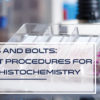Immunohistochemistry Educational Series
In previous installments of the IHC Educational Series, we discussed the specifics of the basic procedures found in the IHC laboratory: immunofluorescence, immunohistochemistry and in situ hybridization. Even though these are different procedures, they all require the following support procedures.
Whenever a new antibody (or probe) is ordered for use by a pathologist for diagnosis using IHC, an antibody validation must be completed which consists of multiple procedures. Initially, analytical sensitivity of the antibody must be performed to determine the appropriate dilution of the antibody, along with the incubation time, conditions and optimal antigen retrieval conditions, if required. The antibody manufacturer will include a product insert sheet which will state the suggested antigen retrieval conditions, primary antibody dilution and incubation time/ conditions; this is where the IHC technician will start.
It is good practice to begin with a dilution series, with the recommended dilution in the middle, bracketed on either side by stronger and weaker dilutions. For example: if the recommended dilution is (1:100), a staining run should be done on sections of the same positive control tissue using dilutions of (1:25), (1:50), (1:100), (1:200) and (1:400) – all at the same incubation time, temperature and antigen retrieval suggested in the insert. The pathologist can then view the slides and determine which dilution results in optimal staining with minimal/ no background stain. After the best dilution is determined, the stain should be repeated using the optimal dilution and conditions on several different tissue types, both positive and negative. This verifies the procedure and measures analytical sensitivity and specificity, as the pathologist can confirm the staining is specific.
Once this is done, the staining protocol should be tested and verified for precision and reproducibility, which actually measures the staining instrument performance. Precision is measured by loading the stainer with serial sections of the selected positive control tissue on one instrument run. All slides should stain identically, which confirms the precision of the stainer.
Reproducibility is measured by staining sequential positive control sections on consecutive instrument staining runs. Again, all slides should stain identically, which confirms that the stain is reproducible, no matter what slide position in the stainer is used and no matter what day or time the stain is run.
Once the procedures of analytic sensitivity, specificity, precision and reproducibility have been successfully completed and signed off by the Medical Director, the antibody is considered validated and ready for use.
Whenever a new lot of antibody is ordered and received, a new Reagent Lot Verification procedure must be completed and signed off by the Medical Director prior to the antibody being used on patient specimens. A new dispenser of the primary antibody should be made up according to the original validation records and used to stain the positive control tissue slide. Ideally, one slide should be stained with the old lot, and another slide stained with the new lot. The Medical Director must view both slides and confirm that the staining is optimal and specific, prior to signing off on the Reagent Lot Verification Form.
References:
- Chapman CM. The Histology Handbook. Amazon CreateSpace Independent Publishing Platform; 2017.
- Chapman CM, Dimenstein IB. Dermatopathology Laboratory Techniques. Amazon CreateSpace Independent Publishing Platform; 2016.
- https://www.ncbi.nlm.nih.gov/probe/docs/techish/
- https://www.sciencedirect.com/topics/neuroscience/in-situ-hybridization
- Bishop JA et al. Detection of Transcriptionally Active High-risk HPV in Patients With Head and Neck Squamous Cell Carcinoma as Visualized by a Novel E6/E7 mRNA In Situ Hybridization Method. American Journal of Surgical Pathology, 36(12):1874-1882; 2012.


